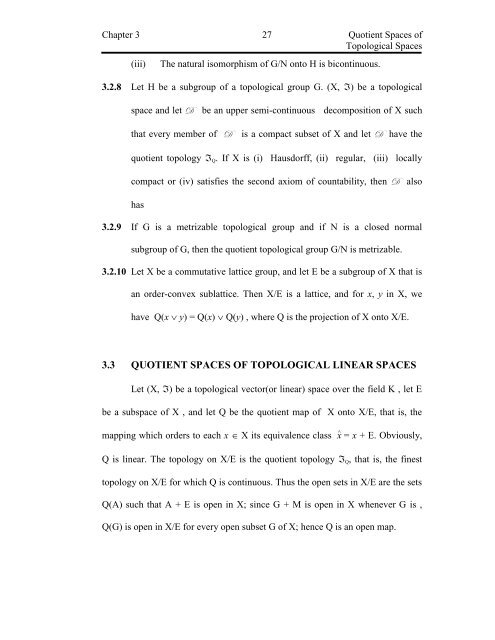chapter 3 quotient spaces of topological spaces
chapter 3 quotient spaces of topological spaces
chapter 3 quotient spaces of topological spaces
Create successful ePaper yourself
Turn your PDF publications into a flip-book with our unique Google optimized e-Paper software.
Chapter 3 27<br />
Quotient Spaces <strong>of</strong><br />
Topological Spaces<br />
(iii) The natural isomorphism <strong>of</strong> G/N onto H is bicontinuous.<br />
3.2.8 Let H be a subgroup <strong>of</strong> a <strong>topological</strong> group G. (X, ) be a <strong>topological</strong><br />
space and let D be an upper semi-continuous decomposition <strong>of</strong> X such<br />
that every member <strong>of</strong> D is a compact subset <strong>of</strong> X and let D have the<br />
<strong>quotient</strong> topology Q. If X is (i) Hausdorff, (ii) regular, (iii) locally<br />
compact or (iv) satisfies the second axiom <strong>of</strong> countability, then D also<br />
has<br />
3.2.9 If G is a metrizable <strong>topological</strong> group and if N is a closed normal<br />
subgroup <strong>of</strong> G, then the <strong>quotient</strong> <strong>topological</strong> group G/N is metrizable.<br />
3.2.10 Let X be a commutative lattice group, and let E be a subgroup <strong>of</strong> X that is<br />
an order-convex sublattice. Then X/E is a lattice, and for x, y in X, we<br />
have Q(x y) = Q(x) Q(y) , where Q is the projection <strong>of</strong> X onto X/E.<br />
3.3 QUOTIENT SPACES OF TOPOLOGICAL LINEAR SPACES<br />
Let (X, ) be a <strong>topological</strong> vector(or linear) space over the field K , let E<br />
be a subspace <strong>of</strong> X , and let Q be the <strong>quotient</strong> map <strong>of</strong> X onto X/E, that is, the<br />
mapping which orders to each x X its equivalence class ^ x = x + E. Obviously,<br />
Q is linear. The topology on X/E is the <strong>quotient</strong> topology Q, that is, the finest<br />
topology on X/E for which Q is continuous. Thus the open sets in X/E are the sets<br />
Q(A) such that A + E is open in X; since G + M is open in X whenever G is ,<br />
Q(G) is open in X/E for every open subset G <strong>of</strong> X; hence Q is an open map.

















